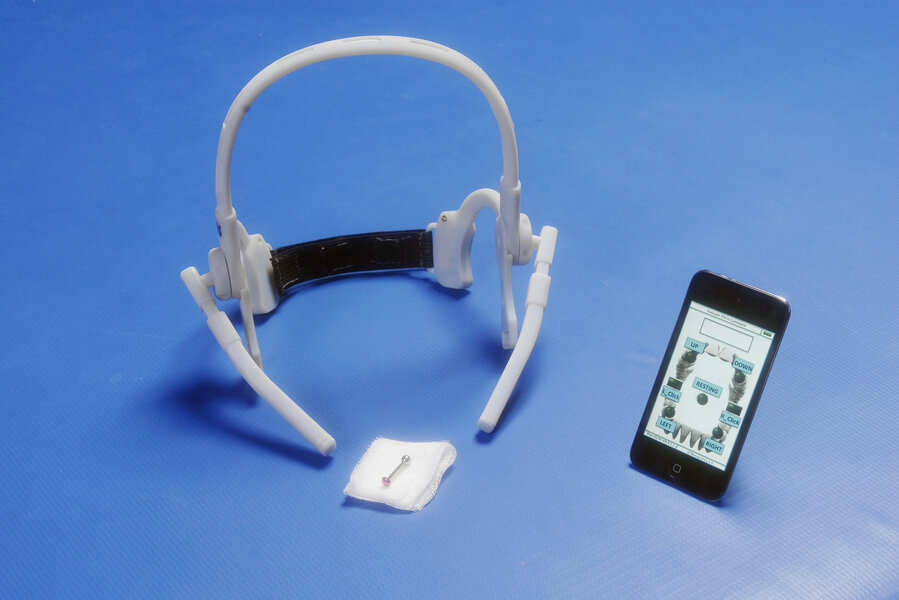Patients drive new wheelchair with their tongues
A new design for an assistive system puts tongue piercings to good use.
A paper published this week in Science Translation Medicine describes a wearable system that allows paralyzed people to navigate their worlds with just flicks of their pierced tongues. The technology, still under development, could help patients disabled from the neck down access their worlds with far greater ease and access than current assistive systems offer – and with a tongue piercing, to boot.
The Tongue Drive System (TDS) works like this: a magnetic tongue stud relays the wearer’s tongue movements to a headset, which then sends the commands to a smartphone or another WiFi-connected device. The user can control almost anything that a smartphone can – and a smartphone can do a lot, including drive a wheelchair, surf the web, and adjust the thermostat.
“This is one assistive device for your entire daily life,” says Maysam Ghovanloo, a professor in the School of Electrical and Computer Engineering at the Georgia Institute of Technology, and the paper’s principal investigator.
TDS is just one of a new crop of innovative assistive technologies for paralyzed patients, along with equipment that tracks eye movements, responds to voice commands, or follows neck movements. Still, these systems have distinct limitations: the neck can tire from prolonged use, background noise muddles voice commands, and eye-tracking headsets are cumbersome. Electrodes implanted in the brain have produced some good results, but they require brain surgery.
The tongue might solve all those problems, says Dr. Ghovanloo.
“The tongue is an amazing part of our bodies,” says Ghovanloo. “It doesn’t get all the appreciation it deserves.”
First, the tongue is a tireless muscle: “I’ve never heard someone at the end of the day say, ‘My tongue is tired from so much talking,’ ” Ghovanloo notes. It is also dexterous: “The size of the motor cortex dedicated to the tongue and mouth rivals that of the fingers and hand,” write the authors, in the paper.
The team is hoping to produce an even smaller version of the already-small device, called iTDS, that could disappear entirely into a patient’s mouth and “eliminate the risk of stigma,” says Ghovanloo.
In their lab tests, researchers compared TDS to one popular assistive system known as sip-and-puff. Users of that system sip or puff air into a straw connected to their wheelchair. The airflow relays commands that move the chair either forward or backward, or to either side.
All of the recruited paralyzed participants had been using sip-and-puff for years. A group of able-bodied participants were also recruited for the research as controls. Everyone that didn’t have a tongue piercing had to get one – which meant that the researchers pierced a lot of tongues.
“Younger patients were quite receptive to receiving a tongue piercing,” says Maysam Ghovanloo. “In general, nobody was afraid of the little pinch and overnight tongue swelling following a tongue piercing.”
In one trial, the participants were timed driving their wheelchairs around a series of obstacles and making certain maneuvers, including a U-turn and backing up, using both TDS and sip-and-puff. The team found that TDS is, on average, three times faster than sip-and-puff, and just as accurate.
“The participants were overwhelmingly positive in favor of TDS,” says Ghovanloo.
In another trial, participants controlled a Windows laptop and an Apple iPod using TDS. Since sip-and-puff does not facilitate computer access, the participants’ performance using TDS was compared against able-bodied participants’ times and error rates using a standard computer mouse. Results showed that the gap between mouse speed and slower TDS times narrowed with experience.
Ghovanloo has founded startup Bionic Sciences Inc to put TDS on the market, but the technology won't be commercially viable for a few more years, he said. The device needs trials outside the controlled environment and FDA approval.






